South Africa
(Page 1 of 1)
Signalling equipment in South Africa was influenced by both British and Dutch practices. Shortly after the formation of the Union of South Africa in 1910, a conference was held to decide upon the standards for signalling that would apply throughout the whole country. Signals were to be broadly in line with contemporary British practice. It was decided that semaphore signals would be of the upper quadrant type (see [2.114]), at a time when lower quadrant signals were still standard in Britain and would remain so for many more years.
To this day, semaphore distant signals in South Africa have arms coloured red [SA.1 & SA.2], although they show a yellow light at night when in the 'on' position [SA.1]. Distant signals were omitted if sighting conditions were good and the permissible speed was low.
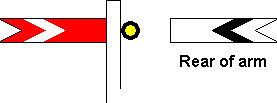 |
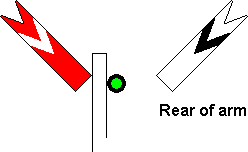 |
[SA.1] Semaphore Distant Signal ('on').

|
[SA.2] Semaphore Distant Signal ('off').
|
In South Africa, the 'outer home' signal performs a special function in connection with permissive working. Accordingly, its arm is distinguished by having a pointed end and a matching white chevron [SA.3 & SA.4]. When in the 'on' position [SA.3], its meaning is "stop and draw in". The driver should stop at the signal then proceed slowly past it, to bring the train within its protection. The outer home signal also serves to protect shunting movements at a station. If an outer home and a distant signal are both required, they will be combined on the one post, with the distant arm being the lower of the two.
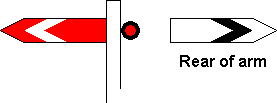 |
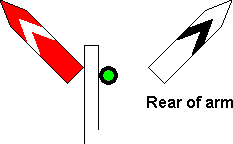 |
|
[SA.3] Outer Home Signal ('on').
|
[SA.4] Outer Home Signal ('off').

|
Signals that apply to goods lines have ringed arms [SA.5 & SA.6].
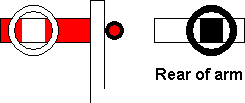 |
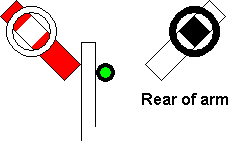 |
|
[SA.5] Ringed Stop Signal ('on').
|
[SA.6] Ringed Stop Signal ('off').
|
A movement from a main signal to a siding is controlled by a short arm fitted with a white rectangle [SA.7 & SA.8].
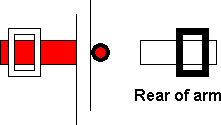 |
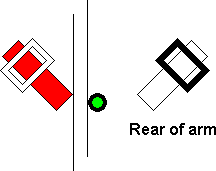 |
|
[SA.7] Siding Signal ('on').
|
[SA.8] Siding Signal ('off').
|
A 'route signal' comprises a semaphore arm mounted on a white disc [SA.9 & SA.10]. The circumstances in which a route signal is used include the following:
- At a diverging junction on a single track railway;
- Where a single track railway diverges from a double track railway (the route signal in this case will be mounted below a stop signal);
- Where a double track railway merges into a single track.
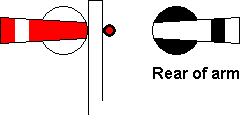 |
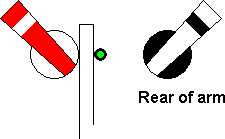 |
[SA.9] Route Signal ('on').

|
[SA.10] Route Signal ('off').
|
Mechanical shunting signals in South Africa are in the form of miniature semaphores, working in the upper quadrant [SA.11 & SA.12].
 |
 |
[SA.11] Miniature Semaphore Shunting Signal ('on').

|
[SA.12] Miniature Semaphore Shunting Signal ('off').
|
Where the provision of shunting signals could not be justified, points indicators were installed. A points indicator shows a red face or light when the related points are lying normal [SA.13]. A yellow face or light indicates that the points have been reversed [SA.14].
 |
 |
|
[SA.13] Points Indicator (normal).
|
[SA.14] Points Indicator (reverse).
|
|
Colour light junction signals were provided with position light type junction indicators. Junction indicator arms were illuminated for diverging routes as per British practice (see [6.51]). Whereas a British junction indicator shows no indication for the 'straight' route, in South Africa a vertical indication is displayed [SA.15]. An illuminated indication comprises four white lights, in contrast to the five lights in a standard British junction indication (see [6.54]). In newer installations, 'direction indicators' are used instead of junction indicators. Direction indicators show the direction of divergence but do not distinguish between individual routes; therefore, only positions 1 and 4, and the vertical indication, are used. A direction indicator comprises just three lights in each indication.
|
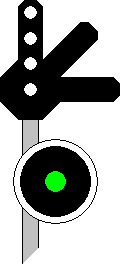 |
|
[SA.15] Junction Indicator - straight route set.
|
|

















